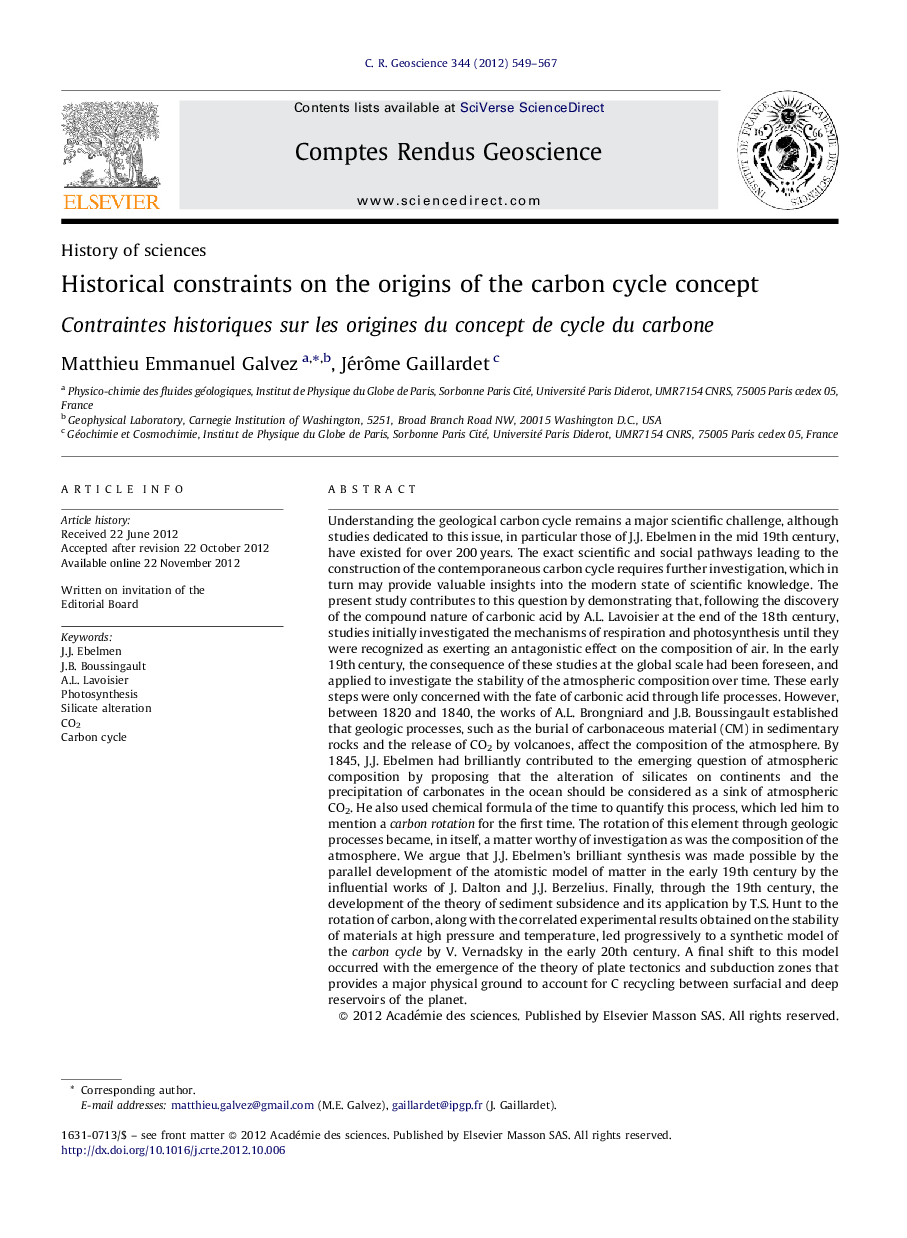| کد مقاله | کد نشریه | سال انتشار | مقاله انگلیسی | نسخه تمام متن |
|---|---|---|---|---|
| 4462480 | 1621563 | 2012 | 19 صفحه PDF | دانلود رایگان |

Understanding the geological carbon cycle remains a major scientific challenge, although studies dedicated to this issue, in particular those of J.J. Ebelmen in the mid 19th century, have existed for over 200 years. The exact scientific and social pathways leading to the construction of the contemporaneous carbon cycle requires further investigation, which in turn may provide valuable insights into the modern state of scientific knowledge. The present study contributes to this question by demonstrating that, following the discovery of the compound nature of carbonic acid by A.L. Lavoisier at the end of the 18th century, studies initially investigated the mechanisms of respiration and photosynthesis until they were recognized as exerting an antagonistic effect on the composition of air. In the early 19th century, the consequence of these studies at the global scale had been foreseen, and applied to investigate the stability of the atmospheric composition over time. These early steps were only concerned with the fate of carbonic acid through life processes. However, between 1820 and 1840, the works of A.L. Brongniard and J.B. Boussingault established that geologic processes, such as the burial of carbonaceous material (CM) in sedimentary rocks and the release of CO2 by volcanoes, affect the composition of the atmosphere. By 1845, J.J. Ebelmen had brilliantly contributed to the emerging question of atmospheric composition by proposing that the alteration of silicates on continents and the precipitation of carbonates in the ocean should be considered as a sink of atmospheric CO2. He also used chemical formula of the time to quantify this process, which led him to mention a carbon rotation for the first time. The rotation of this element through geologic processes became, in itself, a matter worthy of investigation as was the composition of the atmosphere. We argue that J.J. Ebelmen's brilliant synthesis was made possible by the parallel development of the atomistic model of matter in the early 19th century by the influential works of J. Dalton and J.J. Berzelius. Finally, through the 19th century, the development of the theory of sediment subsidence and its application by T.S. Hunt to the rotation of carbon, along with the correlated experimental results obtained on the stability of materials at high pressure and temperature, led progressively to a synthetic model of the carbon cycle by V. Vernadsky in the early 20th century. A final shift to this model occurred with the emergence of the theory of plate tectonics and subduction zones that provides a major physical ground to account for C recycling between surfacial and deep reservoirs of the planet.
RésuméL’étude du cycle géologique du carbone reste un défi scientifique majeur quand bien même 200 années de recherches y ont déjà été consacrées, illustrées notamment par les travaux de J.J. Ebelmen au milieu du xixe siècle. Beaucoup reste à faire pour comprendre dans le détail l’historique de la construction scientifique et sociale du concept de cycle du carbone. Ces données historiques peuvent en retour nous procurer une perspective précieuse sur l’état actuel de la recherche dans ce domaine. Le présent travail est une contribution montrant que depuis la découverte de la nature composée de l’acide carbonique par A.L. Lavoisier à la fin du xviiie siècle, les travaux des scientifiques ont essentiellement concernés les mécanismes de la respiration et de la photosynthèse, jusqu’à ce que ceux-ci soient reconnus comme ayant un effet antagoniste vis-à-vis de la composition de l’air. Au début du xixe siècle, l’application de ces phénomènes antagonistes à l’échelle globale a soulevé de manière très marquée la question de la stabilité de la composition de l’atmosphère au cours des temps géologiques. Alors que ces premiers développements ne concernaient que le devenir de l’acide carbonique atmosphérique au cours des processus impliqués dans le vivant, à partir des années 1820 et durant les 3 décennies suivantes, des processus géologiques tels que l’enfouissement des matériaux biogéniques dans les roches sédimentaires et le dégagement de CO2 volcanique ont été reconnus, par A.L. Brongniard et J.B. Boussingault, comme des processus intervenant également dans la stabilité de la composition de l’atmosphère. En 1845, J.J. Ebelmen a brillamment contribué à cette question en proposant que l’altération des silicates sur les continents, suivie de la précipitation de carbonates dans l’océan, puissent être considérées ensemble comme un puit de CO2 atmosphérique. Il a également utilisé les formules chimiques de l’époque pour proposer une quantification à l’échelle globale de l’effet de ce processus, ce qui l’a conduit à la première formulation d’une rotation du carbone. Ainsi, la rotation de cet élément au cours des processus géologiques devenait en soi un sujet de recherche digne d’intérêt, au même titre que l’avait été l’évolution de la composition de l’atmosphère. Nous suggérons que cette étape majeure n’a été rendue possible que par le développement en parallèle du modèle atomique de la matière, notamment sous l’influence des travaux de J. Dalton et de J.J. Berzelius. Par ailleurs, le développement de la théorie de la subsidence sédimentaire au cours du xixe siècle, et son application à la rotation du carbone par T.S. Hunt, ainsi que les résultats expérimentaux obtenus sur la stabilité des matériaux à hautes pression et température ont progressivement conduit à un modèle synthétique par V. Vernadsky au début du xxe siècle, qui introduisit le terme de cycle du carbone. Enfin, un bouleversement majeur à ce modèle est intervenu avec l’avènement de la théorie de la tectonique des plaques, dont la notion de zone de subduction a fournit un cadre physique majeur permettant de rendre compte du recyclage du carbone entre les réservoirs superficiels et profonds de la planète.
Journal: Comptes Rendus Geoscience - Volume 344, Issues 11–12, November–December 2012, Pages 549–567